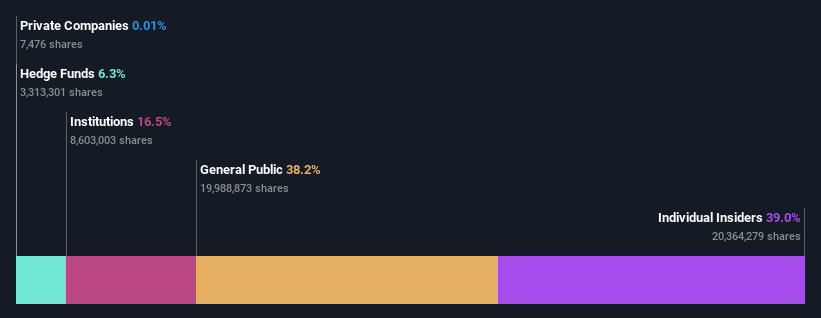Insiders still own 39% of PaySign, Inc. (NASDAQ:PAYS) despite recent sales
Key Insights
PaySign's significant insider ownership suggests inherent interests in company's expansion
The top 7 shareholders own 50% of the company
Every investor in PaySign, Inc. (NASDAQ:PAYS) should be aware of the most powerful shareholder groups. We can see that individual insiders own the lion's share in the company with 39% ownership. Put another way, the group faces the maximum upside potential (or downside risk).
Insiders own the top position in the company’s share registry despite recent sales and as a result, were the biggest beneficiaries of last week’s 11% gain.
In the chart below, we zoom in on the different ownership groups of PaySign.
Check out our latest analysis for PaySign
What Does The Institutional Ownership Tell Us About PaySign?
Institutional investors commonly compare their own returns to the returns of a commonly followed index. So they generally do consider buying larger companies that are included in the relevant benchmark index.
We can see that PaySign does have institutional investors; and they hold a good portion of the company's stock. This implies the analysts working for those institutions have looked at the stock and they like it. But just like anyone else, they could be wrong. If multiple institutions change their view on a stock at the same time, you could see the share price drop fast. It's therefore worth looking at PaySign's earnings history below. Of course, the future is what really matters.
It looks like hedge funds own 6.3% of PaySign shares. That catches my attention because hedge funds sometimes try to influence management, or bring about changes that will create near term value for shareholders. With a 18% stake, CEO Mark Newcomer is the largest shareholder. For context, the second largest shareholder holds about 18% of the shares outstanding, followed by an ownership of 6.3% by the third-largest shareholder.
We also observed that the top 7 shareholders account for more than half of the share register, with a few smaller shareholders to balance the interests of the larger ones to a certain extent.
Researching institutional ownership is a good way to gauge and filter a stock's expected performance. The same can be achieved by studying analyst sentiments. There are plenty of analysts covering the stock, so it might be worth seeing what they are forecasting, too.
Insider Ownership Of PaySign
The definition of company insiders can be subjective and does vary between jurisdictions. Our data reflects individual insiders, capturing board members at the very least. Company management run the business, but the CEO will answer to the board, even if he or she is a member of it.
Most consider insider ownership a positive because it can indicate the board is well aligned with other shareholders. However, on some occasions too much power is concentrated within this group.
It seems insiders own a significant proportion of PaySign, Inc.. Insiders have a US$40m stake in this US$104m business. This may suggest that the founders still own a lot of shares. You can click here to see if they have been buying or selling.
General Public Ownership
With a 38% ownership, the general public, mostly comprising of individual investors, have some degree of sway over PaySign. While this size of ownership may not be enough to sway a policy decision in their favour, they can still make a collective impact on company policies.
Next Steps:
While it is well worth considering the different groups that own a company, there are other factors that are even more important. Be aware that PaySign is showing 2 warning signs in our investment analysis , you should know about...
If you would prefer discover what analysts are predicting in terms of future growth, do not miss this free report on analyst forecasts.
NB: Figures in this article are calculated using data from the last twelve months, which refer to the 12-month period ending on the last date of the month the financial statement is dated. This may not be consistent with full year annual report figures.
Have feedback on this article? Concerned about the content? Get in touch with us directly. Alternatively, email editorial-team (at) simplywallst.com.
This article by Simply Wall St is general in nature. We provide commentary based on historical data and analyst forecasts only using an unbiased methodology and our articles are not intended to be financial advice. It does not constitute a recommendation to buy or sell any stock, and does not take account of your objectives, or your financial situation. We aim to bring you long-term focused analysis driven by fundamental data. Note that our analysis may not factor in the latest price-sensitive company announcements or qualitative material. Simply Wall St has no position in any stocks mentioned.


